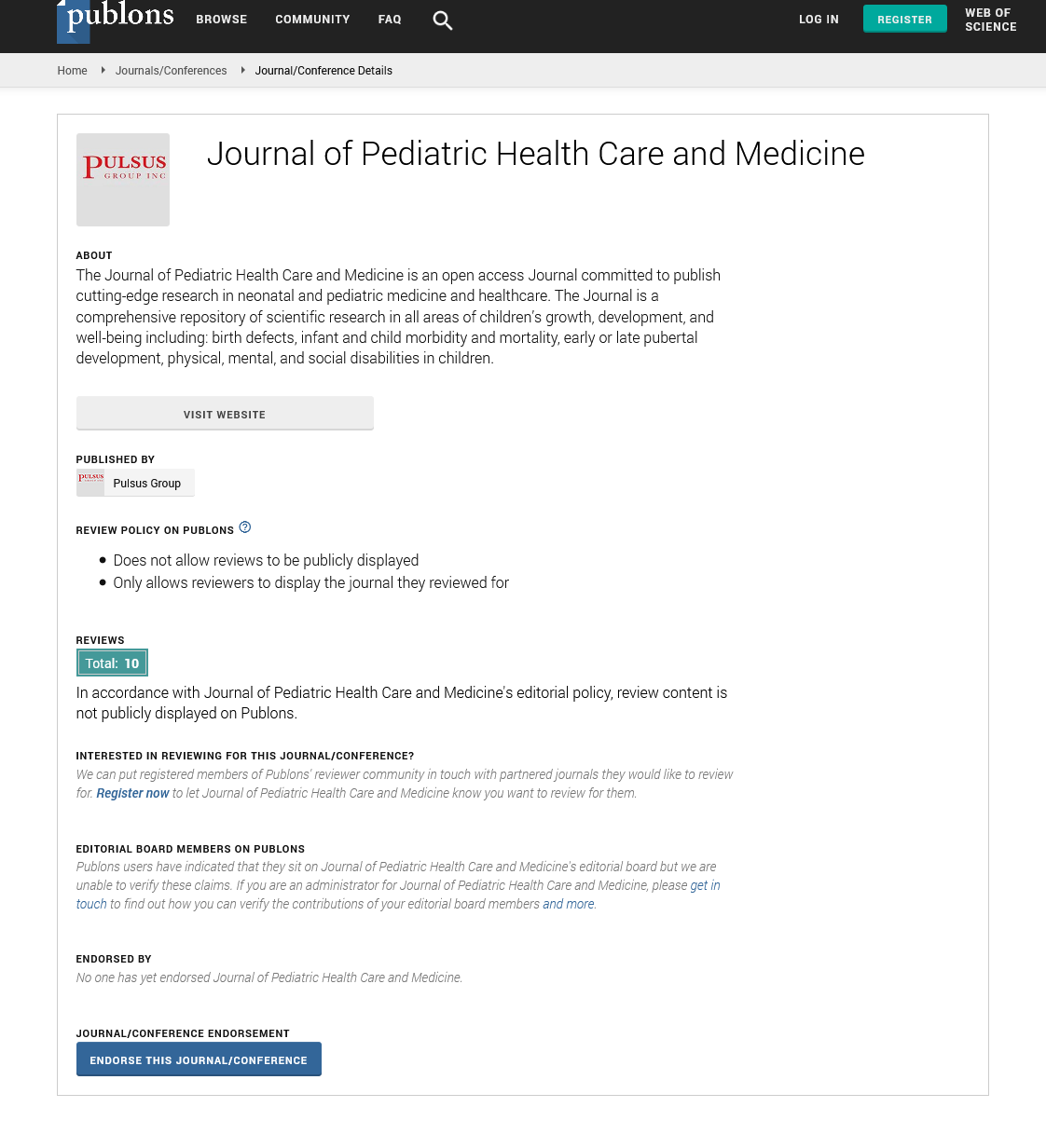Brief discussion on magnetic resonance imaging in craniosynostosis
Received: 07-Jan-2022, Manuscript No. PULJPHCM-22-4109; Editor assigned: 12-Jan-2022, Pre QC No. PULJPHCM-22-4109; Accepted Date: Jan 12, 2022; Reviewed: 15-Jan-2022 QC No. PULJPHCM-22-4109; Revised: 20-Jan-2022, Manuscript No. PULJPHCM-22-4109; Published: 25-Jan-2022, DOI: 10.37532/ puljphcm.2022.5(1).7-8
Citation: Cooper E. Brief discussion on magnetic resonance imaging in craniosynostosis. J Pedia Health Care Med. 2022; 5(1):7-8.
This open-access article is distributed under the terms of the Creative Commons Attribution Non-Commercial License (CC BY-NC) (http://creativecommons.org/licenses/by-nc/4.0/), which permits reuse, distribution and reproduction of the article, provided that the original work is properly cited and the reuse is restricted to noncommercial purposes. For commercial reuse, contact reprints@pulsus.com
Abstract
A congenital disorder in which one or more of the cranial sutures fuse prematurely is known as cranial synostosis. Cranial sutures are articulations between membranous bone plates that, once created, act as the cranial vault’s main growth centers, allowing the brain and cranial vault to expand and grow at the same time. When imaging individuals with craniosynostosis, the MRI protocol with the BB-MRI appears to be a highly promising alternative to CT. This procedure addresses all key areas of preoperative planning in complicated syndromic situations and allows for a safe follow.
Keywords
Craniosynostosis; Facial asymmetry; Magnetic Resonance Imaging (MRI); Radiology
Introduction
Craniosynostosis is a congenital disease in which one or more of the cranial sutures fuse prematurely. Cranial sutures are the articulations between the plates of membranous bone that once developed, serve as the cranial vault’s principal development centers, allowing the brain and cranial vault to expand and grow at the same time. In relation to which and how many sutures are implicated, early pathologic fusion of cranial sutures generates distinctive skull abnormalities, facial asymmetry, and brain development damage [1].
Craniosynostosis is divided into non-syndromic forms, the predominant form, and syndromic forms, based on whether it occurs as a primary disorder or as a result of various underlying causes (such as metabolic, hematological, or teratogenic factors) [2-4]. The sagittal suture is the most often afflicted non-syndromic suture (40%-60% of instances), and the most prevalent syndromes with craniosynostosis are Apert syndrome, pfeiffer syndrome, and crouzon syndrome [5]. Syndromic craniosynostosis is frequently linked to a variety of central nervous system defects, such as Chiari malformation and polymicrogyria [6, 7].
Physical examination and medical imaging are used to diagnose craniosynostosis. Radiology facilitates diagnosis, pre-operative planning, and post-operative follow-up in situations with compound synostosis, syndromic forms, and when a surgical treatment is planned [8, 9].
In newborns, radiological imaging is difficult because many procedures employ ionizing radiations, which are seen as dangerous and avoided, and there is often a requirement for sedation/anesthesia, which increases the likelihood of adverse consequences in this vulnerable group of patients.
In some complex, syndromic, or difficult cases of craniosynostosis, Computed Tomography (CT) scans are unavoidable [10, 11]. Magnetic Resonance Imaging (MRI) is becoming increasingly popular among all of the various radiological technologies accessible today. In reality, MRI avoids the use of ionizing radiations and the possibility of late radiation effects associated with CT, while yet providing many diagnostic benefits. The introduction of MRI offered up new options for researching brain abnormalities related with craniosynostoses such hydrocephalus or tonsillar herniation, as well as detecting and separating cranial bones from cranial sutures, due to technical advancement [12].
MRI was once thought to be a supplementary technique for studying cerebral and craniofacial soft tissue anomalies in craniosynostosis; however, one of the more common and concerning brain anomalies associated with craniosynostosis is the presence of concomitant Dural venous abnormalities, which can be caused by abnormal Dural sinus maturation, venous hypertension, or veno-occlusive disease [13,14]. In these individuals, an MRI venogram can be used to determine the position, shape, and size of the venous sinuses, as well as offer useful information to the surgeon.
Cotton et al. published one of the first articles on MRI and suture analysis in 2005 which looked at the emergence of cranial sutures and craniometric points in an adult population [15]. Sutures revealed as regions of signal vacuum in their imaging procedure. Later, Eley et al. looked into the possible role of MRI in sutures, applying their findings to a pediatric population looking at suture patency [16]. Their imaging protocol included axial T1w, axial T2w, Coronal Fluid–Attenuated Inversion Recovery (FLAIR), Axial Short Tau Inversion Recovery (STIR), and sagittal T1; patent sutures were identified in the axial T2w images by a signal void, which can also be seen in other structures like blood vessels. The need for a specific sequence to provide more detailed information about sutures prompted the same group of authors to create a new sequence, the so-called “Black Bone” MRI (BB MRI), in which contrast between soft tissue and bones is significantly improved; BBMRI allowed visualization of the calvarian bone, sutures, and the craniofacial skeleton [17].
3D volume acquisition, short TE, short TR, and low flip angle are the technical aspects of this sequence. As a result, imaging acquisition periods are minimal, with craniofacial skeleton axial pictures taking an average of 4 minutes. In post-processing, the coronal and sagittal planes are obtained. The cranial sutures emerge as regions of elevated signal intensity on BB-MRI, clearly delineated from the surrounding bone ipointensity. The patent in infants with pathological suture premature fusion sutures continues to have higher signal intensity, but this trait is missing at the synostosis location.
Recently, black-bone imaging has been utilized to create 3D pictures and reconstructions that are extremely valuable to neurosurgeons when planning surgery [18]. Suchyta et al. have showed that this MRI sequence may be used to generate virtual surgical planning for calvarial vault repair [19]. Differentiating between posterior synostotic plagiocephaly and positional plagiocephaly may also be done by BB MRI [20]. The most important drawback of this method is its inherent difficulty in analyzing places where there is an air-bone interaction, such as the paranasal sinuses or the mastoid region.
Discussion
CT scans give information regarding skeletal phenotype, with high suture resolution and evaluation of skull abnormalities, but they are less useful for brain research. On the other hand, MRI is the preferred method for examining brain anatomy and changes, as well as any associated brain diseases such as intracranial herniation or hydrocephalus, venoocclusive disease, and extra cranial involvement, though it plays only a minor role in the evaluation of bone and sutures.
Children with craniosynostosis require a thorough examination of the skull and sutures, as well as the brain parenchyma, with an emphasis on any potential CNS defects that are often present in these individuals.
Because the use of ionizing radiation in children is dangerous, alternative radiological instruments are frequently used to assess pediatric diseases. In craniosynostosis, MRI with a special research protocol, including an inventive and intriguing Black-Bone sequence, allows for the study of the brain and the sutures and bones, as well as 3D reconstructions and all the information the surgeon need. Furthermore, it enables a radiation-free follow-up, preventing continuous ionizing radiation exposure over time.
Conclusion
When imaging individuals with craniosynostosis, the MRI protocol with the BB-MRI appears to be a highly promising alternative to CT. This procedure addresses all key areas of pre-operative planning in complicated syndromic situations and allows for a safe follow-up.
REFERENCES
- Kajdic N, Spazzapan P, Velnar T. Craniosynostosis- Recognition, clinical characteristics, and treatment. Bosn J Basic Med Sci. 2017; 18(2): 110-116.
Google Scholar Cross Ref - Alden TD, Lin KY, Jane JA. Mechanisms of premature closure of cranial sutures. Childs Nerv Syst. 1999; 15 (11-12): 670-675.
Google Scholar Cross Ref - Kabbani H, Raghuveer TS. Craniosynostosis. Am Fam Physician. 2004; 69(12): 2863-2870.
Google Scholar Cross Ref - Pavone P, Corsello G, Marino S, et al. Microcephaly/trigonocephaly, intellectual disability, autism spectrum disorder, and atypical dysmorphic features in a boy with xp22.31 duplication. Mol Syndromol. 2018; 9(5): 253-258.
Google Scholar Cross Ref - Ko JM. Genetic syndromes associated with craniosynostosis. J Korean Neurosurg Soc. 2016; 59(3): 187-191.
Google Scholar Cross Ref - Massimi L, Bianchi F, Frassanito P, et al. Imaging in craniosynostosis: when and what? Child’s Nervous System. 2019; 35(11): 2055-2069.
Google Scholar Cross Ref - Pavone L, Rizzo R, Pavone P. Diffuse polymicrogyria associated with congenital hydrocephalus, craniosynostosis, severe mental retardation, and minor facial and genital anomalies. J Child Neurol. 2000; 15(7): 493-495.
Google Scholar Cross Ref - Cacciaguerra G, Palermo M, Marino L, et al. The evolution of the role of imaging in the diagnosis of craniosynostosis: A narrative review. Children. 2021; 8(9): 1-9.
Google Scholar Cross Ref - Esparza J, Hinojosa J, García-Recuero I, et al. Surgical treatment of isolated and syndromic craniosynostosis. Results and complications in 283 consecutive cases. Neurocirugía. 2008; 19(6):509-29.
Google Scholar Cross Ref - Tan AP. MRI protocol for craniosynostosis: Replacing ionizing radiation-based CT. AJR Am J Roentgenol. 2019; 213(6): 1374-1380.
Google Scholar Cross Ref - Badve CA, K. MM, Iyer RS, et al. Craniosynostosis: imaging review and primer on computed tomography. Pediatr Radiol. 2013; 43(6): 728-742.
Google Scholar Cross Ref - Hayward R, Harkness W, Kendall B, et al. Magnetic resonance imaging in the assessment of craniosynostosis. Scand J Plast Reconstr Surg Hand Surg. 1992; 26(3): 293-299.
Google Scholar Cross Ref - de Goederen R, Cuperus IE, Tasker RC, et al. Dural sinus volume in children with syndromic craniosynostosis and intracranial hypertension. J Neurosurg Pediatr. 2020; 25(5):506-513.
Google Scholar Cross Ref - Copeland AE, Hoffman CE, Tsitouras V, et al. Clinical significance of venous anomalies in syndromic craniosynostosis. Plast Reconstr Surg Glob Open. 2018; 6(1).
Google Scholar Cross Ref - Cotton F, Rozzi FR, Vallee B, et al. Cranial sutures and craniometric points detected on MRI. Surg Radiol Anat. 2005; 27(1): 64-70.
Google Scholar Cross Ref - Eley KA, Mcintyre AG, Watt-Smith SR, et al. “Black bone” MRI: A partial flip angle technique for radiation reduction in craniofacial imaging. Br J Radiol. 2012; 85(1011): 272-278.
Google Scholar Cross Ref - Eley KA, Watt-Smith SR, Sheerin F, et al. “Black Bone” MRI: A potential alternative to CT with three-dimensional reconstruction of the craniofacial skeleton in the diagnosis of craniosynostosis. Eur Radiol. 2014; 24(10): 2417-2426.
Google Scholar Cross Ref - Lethaus B, Gruichev D, Gräfe D, et al. “Blackbone”: The new backbone in CAD/CAM-assisted craniosynostosis surgery? Acta Neurochirurgica. 2021; 163(6): 1735-1741.
Google Scholar Cross Ref - Suchyta MA, Gibreel W, Hunt CH, et al. Using Black Bone Magnetic Resonance Imaging in craniofacial virtual surgical planning. Plast Reconstr Surg. 2018; 141(6): 1459-1470.
Google Scholar Cross Ref - Kuusela L, Hukki A, Brandstack N, et al. Use of black-bone MRI in the diagnosis of the patients with posterior plagiocephaly. Childs Nerv Syst. 2018; 34(7): 1383-1389.
Google Scholar Cross Ref






